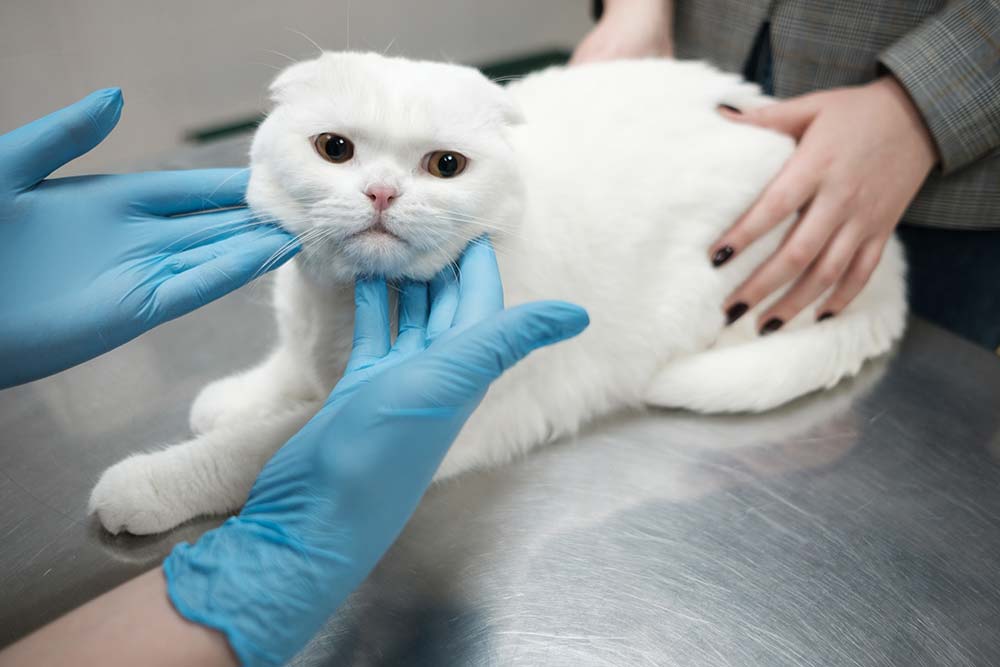Many cats love a good chin scratch! But what if you feel a lump during one of your routine petting sessions? Or maybe you notice your cat rubbing at their chin and closer examination reveals bumps and scabs? As a veterinarian, I have encountered many pet parents worried about such things. Although relatively common, lumps and bumps on the chin can range in severity from feline acne to cancerous growths. In this article, I’ll explain some possible causes (and recommendations for concerned pet parents) of lumps and bumps on a cat’s chin.
Causes of lumps on a cat’s chin
1. Feline acne
The most likely culprit for lumps on a cat’s chin is feline acne, a condition in which keratin becomes trapped in the hair follicles, forming blackheads.
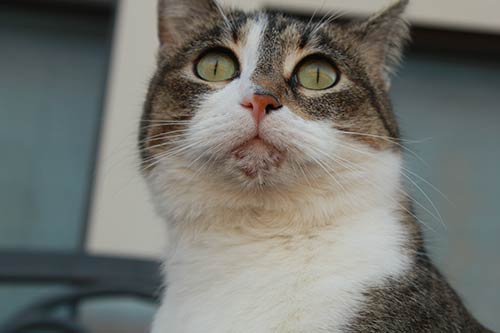
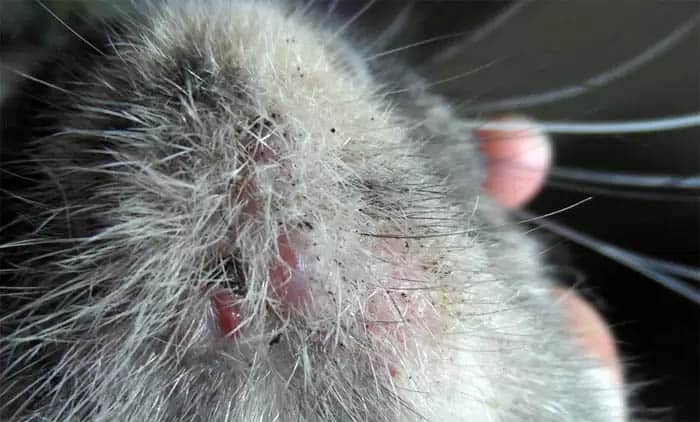
Appearance: Blackheads (often appear similar to dirt) or red, inflamed bumps on the chin or lip area.
Symptoms: Mild itching, localized hair loss, and in severe cases, swelling and discomfort.
Diagnostics: Often, a diagnosis is made on a physical exam, although your veterinarian may recommend additional testing to rule out other conditions.
Treatments: Treatment will vary depending on the severity. Mild cases might not need treatment, or may resolve with the use of topical medicated cleaning wipes or ointments. Switching from plastic to stainless steel or glass food and water bowls can also make a big difference. More severe cases will require oral antibiotics and steroids to help clear infection and manage inflammation.
Prognosis: Generally good with appropriate treatment. However, some cats may have recurring episodes throughout their lives.
2. Eosinophilic granuloma complex
This is a complex composed of three specific types of skin lesions found in cats.
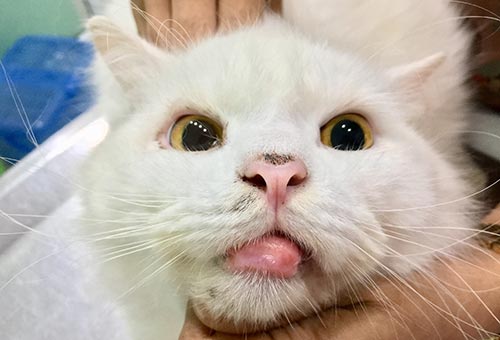
Appearance: Raised, red or yellow, sores or ulcers on the chin or lips; may appear as a linear plaque-like lesion or a larger nodular lump.
Symptoms: Redness, itching, swelling, and sometimes discomfort, pain, or difficulty eating.
Diagnostics: Cytology (collecting a sample of cells for evaluation under the microscope) or biopsy (removing a larger piece of tissue) may be needed for a definitive diagnosis, but your vet may suspect eosinophilic granuloma complex based on a physical exam.
Treatment: Often, these cases are treated with steroids to decrease inflammation, and antibiotics if secondary infection is present. Feeding a hypoallergenic diet and feeding from glass or stainless steel bowls may help decrease recurrence in the future.
Prognosis: Generally good, although some cats may experience recurrent episodes or need ongoing treatment to control the condition or underlying allergy.
3. Dermatitis
Skin infection or inflammation can occur anywhere on the body, including on the chin. Often an underlying allergy could be involved.
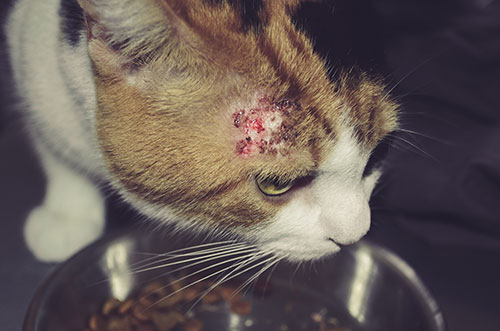
Appearance: Red, inflamed skin that may appear swollen, crusty, or scaly. Lumps, pustules (pimples), and scabs may be present.
Symptoms: Itching, scratching, hair loss, and skin lesions.
Diagnostics: May include skin testing such as cytology, skin scrape, or culture to identify the organism causing infection. Additional testing to determine an underlying allergy may also be needed.
Treatment: Mild cases should resolve with topical treatments such as medicated wipes or ointments containing antibiotics, antifungals, and steroids. More severe cases may require oral antibiotics and steroids. Identifying and treating the underlying cause (such as an allergy), if there is one, is also critical to prevent recurrence.
Prognosis: Generally good once the underlying cause or source of the allergy is identified and treated, although some cats may have recurrent bouts of dermatitis.
4. Abscess
An abscess is a localized infection (collection of pus) that can form after an injury. Cat bite wounds are common causes, especially if your cat goes outdoors. An infected tooth also has the potential to cause an abscess on the face.
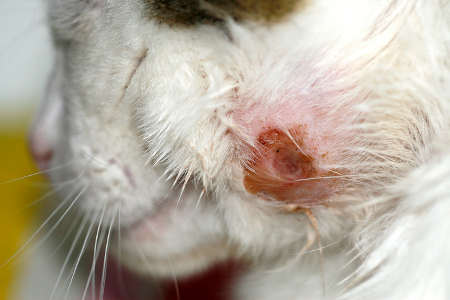
Appearance: A red, soft, swollen, and painful lump that may be warm to the touch. An abscess may rupture and leak pus or fluid.
Symptoms: Localized pain and the possibility of systemic signs of infection such as fever, decreased appetite, and lethargy.
Diagnostics: Physical exam and collection of fluid from the mass.
Treatments: Depending on the size and severity, the area may need to be cleaned and drained, sometimes involving a surgical procedure. Treatment also involves antibiotics and pain management.
Prognosis: Excellent after appropriate treatment.
5. Benign or cancerous growths
Skin lumps and bumps can also occur anywhere on the body. This encompasses benign growths (such as cysts, warts, or lipomas) and cancerous tumors (such as squamous cell carcinoma, mast cell tumor, fibrosarcoma, basal cell carcinoma, and melanoma).
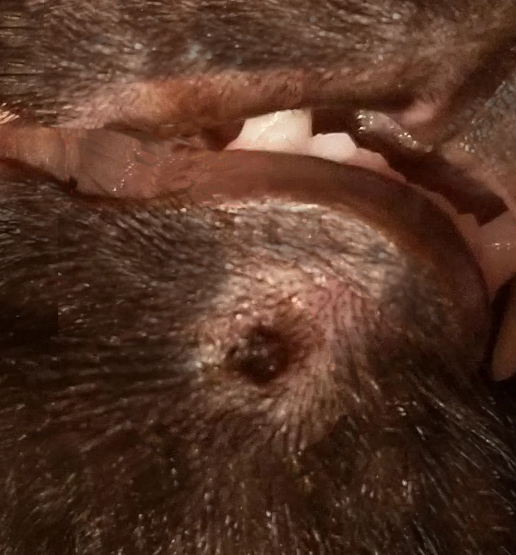
Even the most experienced vet will not be able to determine the type of mass just by looking; therefore ANY new mass that you find on your cat’s body deserves a visit to the vet for a thorough workup.
Appearance: The appearance can be extremely variable – small, large, soft, firm, cutaneous (on the surface of the skin), subcutaneous (underneath the surface of the skin), fluid-filled, bleeding, oozing, ulcerated, infected, pigmented, etc.
Symptoms: In many cases, there may be no other symptoms besides the presence of a mass, while in others, your cat may show signs of pain or discomfort.
Diagnostics: Cytology and biopsy are two ways that a mass can be sampled and evaluated to determine the type of tumor and whether it is benign or malignant.
Treatments: Treatment will depend on the test results, but will generally involve surgical removal. In some cases, referral to an oncologist for chemotherapy or radiation may be indicated.
Prognosis: Variable, depending on the type of tumor, how early it was detected, and the effectiveness of the treatment.
When to seek veterinary treatment for lump on cat’s chin
ANY new, changing, or worrisome lump on your cat’s body should prompt a vet visit. Be sure to look out for changes in your cat’s behavior and eating habits, or if the lump changes in size or appearance. If you notice these things, or if the lump appears infected or is oozing or bleeding, your cat should be seen right away.
What to expect at the vet
1. Diagnostic testing
Your vet will start by getting a history and performing a nose-to-tail physical exam. Depending on their initial assessment, several diagnostic tests may be recommended, such as:
Skin cytology or scraping: A small sample of skin is examined under the microscope to look for evidence of yeast or bacteria causing infection. If present, a culture may be used to grow the organism and help determine the best treatment options.
Fine Needle Aspiration: A small needle is used to collect cells from inside the lump for evaluation.
Biopsy: A larger sample of the lump is removed for detailed examination under a microscope. This might require sedation or anesthesia.
Allergy tests: If the vet suspects an allergy, they may draw blood for testing or perform specific skin tests. A diet trial may be used to diagnose and treat a food allergy.
2. Treatments
Depending on the diagnosis, your vet will recommend a treatment plan, which could include:
Topical treatments: These might be creams, wipes, ointments, or medicated shampoos designed to soothe inflammation and clear up any infections.
Oral medications: If the lump is infected or inflamed, oral antibiotics or steroids might be prescribed.
Surgery: For some types of lumps such as cysts or tumors, surgical removal might be the best option.
Dietary changes or other management of underlying allergies: If allergies are a suspected cause, a change in diet might be recommended. Your vet may also recommend other medications or environmental modifications to help manage flea, contact, or environmental allergies.
3. Cost
Cost is difficult to predict as it can vary greatly depending on many factors; however, a range of cost estimates is listed below.
Exam: $50-80
Fine needle aspirate or cytology: $25-100
Biopsy: $150-500
Bloodwork: $100-300
Topical medications: $20-50
Oral medications: $20-100
Surgery: $200-1000+
How to prevent lumps on a cat’s chin
While in some cases it is not possible to prevent a lump from developing on your cat’s chin, other cases may be prevented by using stainless steel or glass food and water bowls, feeding a high quality complete and balanced diet, using consistent flea prevention year-round, regularly grooming your cat, and avoiding the use of products that are not explicitly safe for cats or may cause skin irritation.
